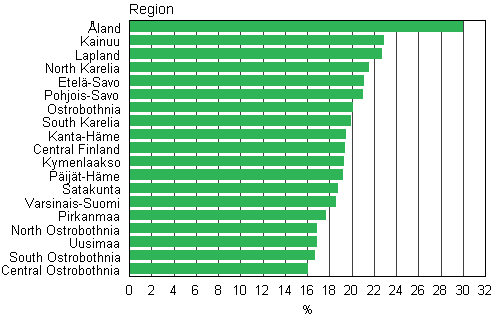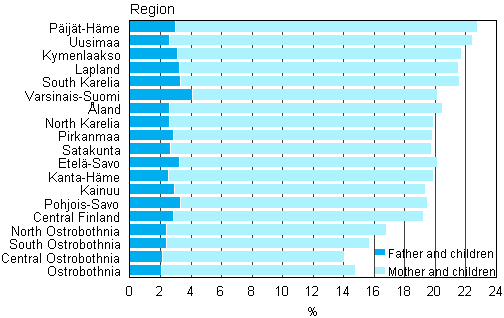4. Regional differences in prevalence of families with underage children are small
4.1 Share of cohabiting couples highest in Åland, Kainuu and Lapland
The commonest type of family with children in all regions is one of a married couple although there are also clear differences in this. The differences arise from the prevalence of families of cohabiting couples and one-parent families in the regions. Åland, Kainuu and Lapland have the highest relative numbers of cohabiting couples. In Central Ostrobothnia the share of cohabiting families is lowest in all country.
In Åland 30 per cent and in Kainuu and Lapland 23 per cent of all families with underage children are families of cohabiting couples. The share of cohabiting couples is higher than the average for the whole country in 14 regions and lower than the average in five regions (Figure 7).
Figur 7. Families of cohabiting couples as a proportions of families with underage children by region in 2011

When examining the prevalence of cohabiting couples by municipality, the municipalities of Åland are in the lead. Of the municipalities of Mainland Finland, Luhanka in the region of Central Finland is at the top of the list with 36 per cent. In Savukoski 33 per cent of families with underage children are families of cohabiting couples. In Närpiö and Suomenniemi the respective proportion is 31 per cent and in Pelkosenniemi and Suomussalmi 30 per cent. The municipality in Mainland Finland with the lowest share of seven per cent of families of cohabiting couples with children is Luoto.
4.2 Päijät-Häme has highest proportions of one-parent families with children, Ostrobothnia lowest
There is also clear regional variation in the prevalence of one-parent families. In the figures for the regions, the Ostrobothnian regions differ from other regions in favour of the conventional family (Figure 8). The number of one-parent families is lowest there. The number of one-parent families is highest in Päijät-Häme (23%) and Uusimaa (22%). Lahti puts the share up for Päijät-Häme and Helsinki for Uusimaa.
Figure 8. Proportion of single-parent families of all families with underage children by region in 2011

The regional variation in the proportion of one-parent families with children is due to the different proportions in families of the type mother and children. The proportion of families of the type father and children ranges from two to three per cent in all regions, with the exception of Åland, where the proportion has risen to four per cent.
Examined by municipality in Mainland Finland, the proportions of one-parent families with children are the highest in Utsjoki (29%), Helsinki and Hartola (28%), and in Turku and Kemi (27%). Åland has the highest figures in the whole of Finland (Sottunga 40%, Kökar 33% and Mariehamn 28%) but in the case of Sottunga and Kökar it should be borne in mind that in such small municipalities the difference of just a couple of family types can alter the percentage share considerably.
In Mainland Finland, the lowest relative proportions of one-parent families can be found in Luoto (4%), Pedesöre (5%) and Yli-Ii (6%) and in Åland in Vårdö (4%).
Luoto could be viewed as the most conventional municipality in terms of family structure, because it has the lowest proportion of one-parent families with children and the highest proportion of married couples in the whole country. Luoto also has the seventh highest average number of 2.71 of underage children living at home per family. Higher figures are reached in Yli-Ii (2.88), Sievi (2.81) and Perho (2.80). The average for the whole country is 1.83.
The most common marital status of the fathers and mothers of one-parent families with children is divorced, this being so for 53 per cent of the fathers and 44 per cent of the mothers. Only five per cent of the fathers and three per cent of the mothers are widowed. Dissolved cohabiting partnerships have increased the numbers of unmarried mothers or fathers of one-parent families with underage children. As many as 41 per cent of the mothers of mother and children families and 27 per cent of the fathers of father and children families are unmarried (Table 3, Chapter 1).
Source: Population and Cause of Death Statistics, Statistics Finland
Inquiries: Marjut Pietiläinen 09 1734 2798, Timo Nikander 09 1734 3250, vaesto.tilasto@stat.fi
Director in charge: Jari Tarkoma
Updated 9.11.2012
Official Statistics of Finland (OSF):
Families [e-publication].
ISSN=1798-3231. Annual Review 2011,
4. Regional differences in prevalence of families with underage children are small
. Helsinki: Statistics Finland [referred: 11.1.2026].
Access method: http://stat.fi/til/perh/2011/02/perh_2011_02_2012-11-09_kat_004_en.html

